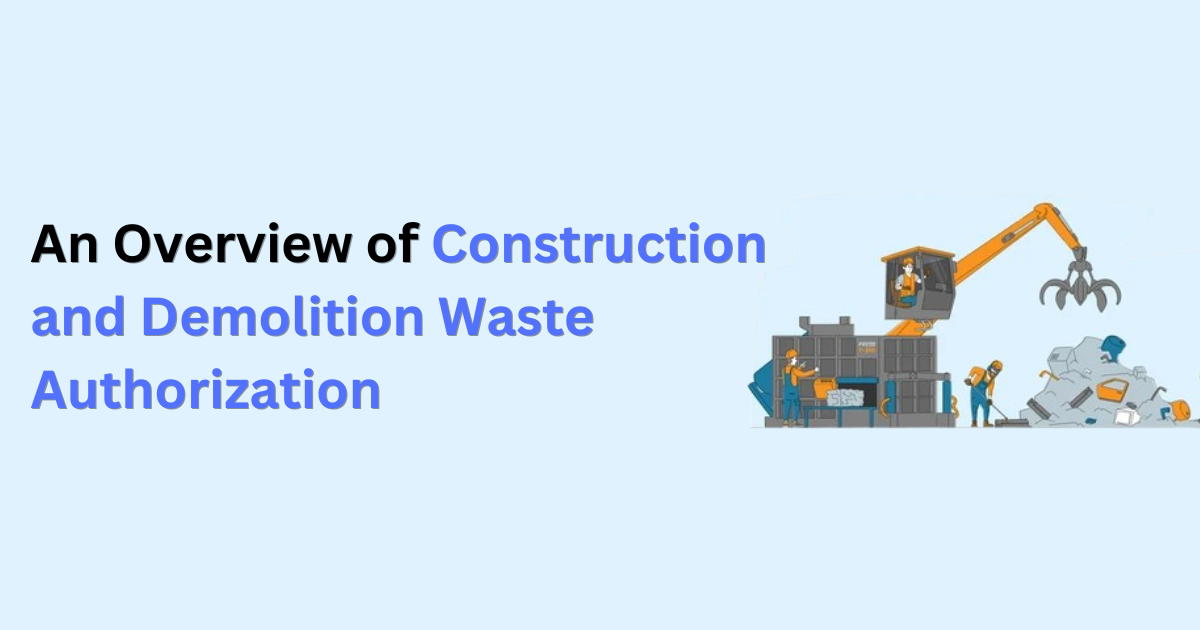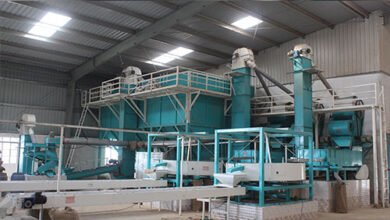
An Overview of Construction and Demolition Waste Authorization: Promoting Sustainable Practices
Introduction
Construction and Demolition (C&D) waste, comprising debris from building and infrastructure projects, is a significant environmental concern. In response to these challenges, Construction and Demolition Waste Authorization has emerged as a crucial framework for regulating and promoting sustainable practices in waste management.
Need for Construction and Demolition Waste Management
The rapid pace of urbanization and infrastructure development has brought unprecedented growth, but it has also generated a significant byproduct: Construction and Demolition (C&D) waste. This waste, arising from construction, renovation, and demolition activities, poses a considerable environmental challenge. The need for effective Construction and Demolition Waste Management is paramount, driven by several crucial factors.
1. Environmental Impact:
- Landfill Overload: Improper disposal of C&D waste often leads to overflowing landfills, contributing to soil degradation and loss of valuable land.
- Resource Depletion: Construction activities consume vast amounts of natural resources. Ineffective waste management results in the unnecessary depletion of these resources.
2. Public Health Concerns:
- Air and Water Pollution: Unregulated dumping and inadequate waste management practices can lead to the release of pollutants into the air and water, impacting public health.
- Hazardous Materials: C&D waste may contain hazardous materials, posing a risk to those exposed directly or indirectly.
3. Legal and Regulatory Imperatives:
- Compliance Requirements: Governments and regulatory bodies are increasingly implementing stringent regulations for C&D waste management to ensure compliance with environmental standards.
- Authorization Mandates: Obtaining Construction and Demolition Waste Authorization is becoming a legal prerequisite, emphasizing the need for businesses to adhere to proper waste management practices.
4. Resource Recovery and Circular Economy:
- Waste as a Resource: Many components of C&D waste can be recycled or repurposed. Proper waste management allows for resource recovery, contributing to a more sustainable and circular economy.
- Reducing Environmental Footprint: Incorporating recycled materials into new construction projects reduces the demand for virgin resources, lowering the overall environmental footprint.
5. Urban Aesthetics and Livability:
- Visual Impact: Unregulated dumping and accumulation of C&D waste can negatively impact the aesthetics of urban areas, affecting the overall livability and attractiveness of a locality.
- Community Well-being: A clean and well-maintained urban environment enhances community well-being and fosters a sense of pride among residents.
6. Economic Considerations:
- Resource Efficiency: Efficient waste management practices contribute to resource efficiency, reducing the overall cost of construction by promoting the reuse of materials.
- Job Creation: The establishment of recycling facilities and waste management services creates employment opportunities, contributing to economic growth.
7. Sustainable Urban Development:
- Smart Cities Initiative: Many cities worldwide are striving to become ‘smart cities’ by integrating sustainable practices. Effective C&D waste management is a crucial aspect of this initiative.
- Long-Term Planning: Sustainable urban development necessitates long-term planning that includes proper waste management to ensure the well-being of current and future generations.
8. Corporate Social Responsibility (CSR):
- Ethical Business Practices: Adhering to responsible waste management practices aligns with corporate social responsibility, reflecting positively on a company’s reputation and ethical standing.
- Community Engagement: Engaging with local communities and addressing their concerns regarding waste management enhances a company’s relationship with its surroundings.
Construction and Demolition Waste Authorization Process
Construction and Demolition (C&D) Waste Authorization is a crucial step in ensuring responsible waste management practices in the construction and infrastructure development sector. The Authorization process involves a series of steps designed to assess, regulate, and monitor entities engaged in handling C&D waste. Here is an in-depth overview of the Construction and Demolition Waste Authorization process:
1. Understanding Authorization Requirements:
- Identification of Applicable Entities: Entities involved in construction, renovation, or demolition activities must understand whether they fall under the purview of C&D waste Authorization.
- Legal Framework Compliance: Familiarizing oneself with the legal and regulatory requirements pertaining to C&D waste management is essential.
2. Preparing Authorization Application:
- Documentation: Entities seeking Authorization must compile a comprehensive set of documents, including details of their operations, waste management plan, and environmental impact assessment if required.
- Application Form Submission: Submission of a duly filled application form, along with the required documents, initiates the Authorization process.
3. Evaluation and Screening:
- Technical Evaluation: Regulatory authorities conduct a technical evaluation of the application, assessing the feasibility and adequacy of the proposed waste management plan.
- Environmental Impact Assessment: In some cases, an environmental impact assessment may be required to evaluate potential environmental repercussions and propose mitigation measures.
4. Site Inspection and Verification:
- On-Site Inspection: Regulatory bodies often conduct on-site inspections to verify the accuracy of the information provided in the application.
- Infrastructure Assessment: The inspection includes an assessment of the entity’s infrastructure and facilities for C&D waste management.
5. Approval and Conditions:
- Authorization Grant: Upon successful evaluation and verification, regulatory authorities grant Construction and Demolition Waste Authorization.
- Imposition of Conditions: Authorities may impose specific conditions and obligations that entities must adhere to during waste management operations. These conditions are aimed at ensuring responsible and sustainable practices.
Key Components of Construction and Demolition Waste Management**
Construction and Demolition (C&D) Waste Management is a complex process that involves a range of practices aimed at minimizing waste, maximizing resource recovery, and promoting sustainability in the construction industry. The key components of effective C&D waste management encompass various stages from waste generation to its final disposal or reuse.
1. Waste Segregation and Collection:
- On-Site Segregation: Encouraging on-site segregation of C&D waste ensures that different types of materials, such as concrete, wood, metals, and plastics, are separated at the source.
- Collection Systems: Implementing efficient collection systems to gather segregated waste and transport it to designated facilities for further processing.
2. Recycling and Reuse Strategies:
- Material Recovery Facilities (MRFs): Establishing Material Recovery Facilities for the systematic sorting and separation of recyclable materials from C&D waste.
- Recycling Facilities: Setting up recycling facilities to process materials like concrete, bricks, and metals for reuse in construction projects, reducing the demand for virgin resources.
3. Responsible Disposal Methods:
- Landfill Alternatives: Minimizing reliance on traditional landfills and exploring alternative disposal methods such as waste-to-energy facilities or engineered landfills.
- Hazardous Waste Handling: Implementing specialized disposal methods for hazardous components within C&D waste to prevent environmental contamination.
4. Innovation in C&D Waste Management Practices:
- Advanced Technologies: Embracing advanced technologies, such as waste tracking systems and digital platforms, to streamline waste management processes and enhance efficiency.
- Innovative Recycling Techniques: Exploring innovative techniques for recycling complex materials like composite materials and mixed plastics.
5. Regulatory Compliance and Authorization:
- Construction and Demolition Waste Authorization: Obtaining proper Authorization in compliance with regulatory frameworks to engage in C&D waste management activities.
- Adherence to Standards: Ensuring that all waste management practices adhere to prescribed standards and guidelines to maintain Authorization status.
Challenges in Construction and Demolition Waste Management
Construction and Demolition (C&D) Waste Management, while crucial for environmental sustainability, faces various challenges that hinder its effective implementation. Recognizing and addressing these challenges is essential for developing resilient waste management strategies within the construction industry. Here are some key challenges:
1. Lack of Awareness and Education:
- Limited Stakeholder Awareness: Many construction industry stakeholders, including workers, contractors, and project managers, may have limited awareness of the importance of proper C&D waste management.
- Inadequate Training: Insufficient training programs on waste segregation, recycling, and disposal practices can result in improper handling of materials on construction sites.
2. Inadequate Infrastructure:
- Limited Processing Facilities: In some regions, there may be a lack of adequate facilities for processing and recycling C&D waste, leading to an overreliance on landfills.
- Transportation Challenges: Insufficient transportation infrastructure can impede the efficient movement of waste from construction sites to processing facilities.
3. Economic Implications:
- Cost of Recycling: Recycling C&D waste can be more expensive than traditional disposal methods, impacting the economic feasibility of recycling initiatives.
- Market Demand for Recycled Materials: The lack of sufficient demand for recycled construction materials in the market can discourage businesses from investing in recycling efforts.
4. Regulatory Compliance Burden:
- Complex Regulatory Frameworks: Navigating and complying with diverse and complex regulatory frameworks for C&D waste management can be challenging for businesses.
- Authorization Process Difficulty: Obtaining Construction and Demolition Waste Authorization may be a time-consuming and bureaucratic process, deterring some entities from seeking compliance.
5. Enforcement and Monitoring Challenges:
- Inadequate Monitoring: Limited monitoring and enforcement mechanisms may result in non-compliance with waste management regulations, allowing some entities to neglect responsible practices.
- Lack of Penalties: Inconsistent penalties or consequences for non-compliance may weaken the deterrent effect on businesses that violate waste management standards.
Solutions and Best Practices
Addressing the challenges in Construction and Demolition (C&D) Waste Management requires the implementation of robust solutions and best practices. By adopting innovative strategies and promoting responsible waste management practices, the construction industry can contribute significantly to environmental sustainability. Here are key solutions and best practices:
1. Public Awareness Campaigns:
- Launching comprehensive public awareness campaigns to educate the public, construction professionals, and businesses about the importance of C&D waste management.
- Promoting the benefits of responsible waste disposal and the positive environmental impact of recycling and reuse.
2. Training and Capacity Building:
- Establishing training programs to educate construction workers, contractors, and project managers on proper waste segregation, recycling, and disposal practices.
- Providing certifications or incentives for individuals and businesses that undergo training and demonstrate proficiency in waste management.
3. Infrastructure Development:
- Investing in the development of advanced waste processing facilities, Material Recovery Facilities (MRFs), and recycling plants to enhance the capacity for handling C&D waste.
- Improving transportation infrastructure to facilitate the efficient movement of waste from construction sites to processing facilities.
4. Economic Incentives:
- Introducing economic incentives such as tax benefits, subsidies, or grants for businesses that adopt sustainable C&D waste management practices.
- Creating market opportunities for recycled construction materials by encouraging public and private sector procurement of such materials.
5. Collaboration and Stakeholder Engagement:
- Facilitating collaboration and communication between government bodies, contractors, waste management facilities, and the public.
- Encouraging partnerships between construction companies and waste management entities to streamline waste collection and processing.
Future Trends in Construction and Demolition Waste Management
As the construction industry continues to evolve, future trends in Construction and Demolition (C&D) Waste Management are poised to play a pivotal role in shaping a more sustainable and environmentally responsible sector. Anticipating and embracing these trends can lead to improved waste reduction, resource recovery, and overall environmental stewardship. Here are the key future trends:
1. Advanced Waste Sorting Technologies:
- Automated Sorting Systems: The integration of automated sorting systems using artificial intelligence and robotics for more precise and efficient separation of different materials in C&D waste streams.
- Sensor-Based Technologies: Adoption of sensor-based technologies to enhance the accuracy of waste sorting and increase the recovery rate of recyclable materials.
2. Digital Platforms for Waste Tracking:
- Blockchain Technology: Implementation of blockchain technology to create transparent and traceable records of C&D waste movements, promoting accountability and reducing the risk of illegal dumping.
- Digital Platforms: Development of digital platforms and mobile applications to track, monitor, and manage C&D waste from generation to disposal, facilitating real-time data access for stakeholders.
3. Prefabrication and Modular Construction:
- Prefabrication Practices: Increased adoption of prefabrication and modular construction methods to reduce on-site waste generation by optimizing material usage and minimizing construction waste.
- Design for Deconstruction: Emphasis on designing buildings with deconstruction in mind, allowing for easier disassembly and salvage of materials at the end of a structure’s lifecycle.
4. Circular Economy Integration:
- Material Passport: Implementation of material passports, documenting the entire lifecycle of construction materials, promoting their reuse and recycling in a circular economy.
- Closed-Loop Systems: Growing emphasis on creating closed-loop systems where materials are continuously cycled through use, recycling, and reuse to minimize waste generation.
5. Sustainable Construction Materials:
- Innovative Materials: Development and use of innovative and sustainable construction materials that have a reduced environmental impact and are easier to recycle or repurpose.
- Biodegradable Alternatives: Exploration of biodegradable construction materials to further minimize the environmental footprint of construction activities.
Importance of Stakeholder Collaboration in Construction and Demolition Waste Management
Stakeholder collaboration plays a crucial role in the success of Construction and Demolition (C&D) Waste Management initiatives. The construction industry involves a diverse range of participants, including government bodies, contractors, waste management facilities, communities, and environmental organizations. Collaborative efforts among these stakeholders are essential for achieving sustainable waste management practices.
Conclusion
The article recaps the significance of Construction and Demolition Waste Authorization in promoting responsible waste management practices. It underscores the role of Authorization in contributing to sustainable development goals and issues a call to action for all stakeholders to prioritize responsible construction and demolition practices. Through comprehensive waste management and a commitment to sustainable practices, the construction industry can play a pivotal role in building a more environmentally conscious future.
Read More – Believing These 9 Myths About Cash For Junk Cars Orangeville Keeps You From Growing




